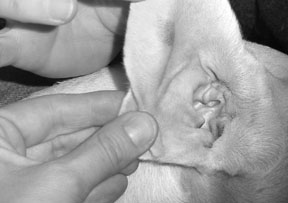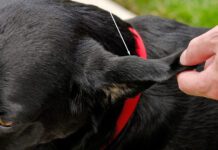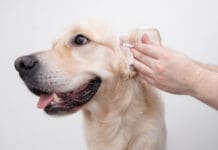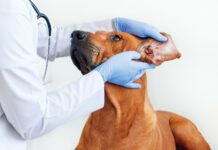DOG EAR INFECTION: OVERVIEW
1. Keep your dog’s ears clean. Use a gentle cleaning agent such as green tea, or a commercial product such as Halo’s Natural Herbal Ear Wash.
2. Use a pinch of boric acid to keep the dog’s ears dry and acidified.
3. Consult your holistic veterinarian in cases of severe or chronic infections; she may need to treat an underlying condition.
Chronic dog ear infections are the bane of long-eared dogs, swimming dogs, recently vaccinated puppies, old dogs, dogs with an abundance of ear wax, and dogs with allergies, thyroid imbalances, or immune system disorders. In other words, ear infections are among the most common recurring canine problems.
In conventional veterinary medicine, a dog ear infection can often be treated with oral antibiotics, topical drugs, or even surgery. The problem is that none of these treatments is a cure. Ear infections come back when the dog eats another “wrong” food, goes for another swim, experiences another buildup of excess wax, or in some other way triggers a reoccurrence.

Holistic veterinarian Stacey Hershman, of Nyack, New York, took an interest in dog ear infections when she became a veterinary technician in her teens. “This is a subject that isn’t covered much in vet school,” she says. “I learned about treating ear infections from the veterinarians I worked with over the years. Because they all had different techniques, I saw dozens of different treatments, and I kept track of what worked and what didn’t.”
Over the years, Dr. Hershman developed a program for keeping ears healthy and treating any problems that do arise, without the steroids and antibiotics usually dispensed by conventional practitioners. In addition, when she treats a dog with infected ears, she usually gives a homeopathic remedy to stimulate the dog’s immune system and help it fight the infection’s underlying cause.
“Ear infections are a symptom of a larger problem,” she says. “You don’t want to just treat the ear and ignore the rest of the body. You want to treat the whole patient.”
Dr. Hershman believes that many dog ear infections, especially in puppies, stem from immune system imbalances caused by vaccinosis, a reaction to vaccines. “The ill effects of vaccines,” she says, “can cause mucoid discharge in puppies. For example, it’s not uncommon for puppies to have a discharge from the eyes or to develop conjunctivitis after a distemper vaccine.”
Once a dog develops an ear infection, conventional treatment can make the problem worse. “Dogs are routinely given cocktail drugs, which are combinations of antibiotics, antifungal drugs, cortisone, or other ingredients,” she explains.
“After a while, you’ll go through 10 tubes, and your dog will develop a resistance. Then you’ll have to go to more powerful drugs to treat the recurring infection. In conventional veterinary medicine, chronic ear infections are considered normal. Dog owners are told they’re a fact of life, they’re never cured, they just keep coming back, and the best you can do is ‘manage’ them. My goal is to cure, not to manage.”
Dr. Hershman’s treatment for infected ears is not a cure by itself, but it’s a remedy that isn’t harmful, and it gives you an important kick-start in treating ears holistically. “That’s the approach that leads to a cure,” she says.
Note: If your dog develops an ear infection for the first time, or if his condition seems especially severe or painful, take him to see your holistic veterinarian, to rule out a tumor, polyp, or something else that requires veterinary attention.
Maintenance Ear Cleaning
Dr. Hershman’s healthy ears program starts with maintenance cleaning with ordinary cotton balls and cotton swabs. “This makes a lot of people nervous,” she says, “but the canine ear canal isn’t straight like the canal in our ears. Assuming you’re reasonably gentle, you can’t puncture the ear drum or do any structural damage.”
Moisten the ear with green tea brewed as for drinking and cooled to room temperature, or use an acidic ear cleanser that does not contain alcohol. Dr. Hershman likes green tea for its mildness and its acidifying, antibacterial properties, but she also recommends peach-scented DermaPet MalAcetic Otic Ear Cleanser or Halo Natural Herbal Ear Wash.
“Don’t pour the cleanser into the dog’s ear,” she warns, “or it will just wash debris down and sit on the ear drum, irritating it.” Instead, she says, lift the dog’s ear flap while holding a moistened cotton ball between your thumb and index finger. Push the cotton down the opening behind the tragus (the horizontal ridge you see when you lift the ear flap) and scoop upward. Use a few dry cotton balls to clean out normal waxy buildup.
Next, push a Q-tip into the vertical ear canal until it stops, then scoop upward while rubbing it against the walls of the vertical canal. Repeat several times, rubbing on different sides of the vertical canal. Depending on how much debris is present in each ear, you can moisten one or several cotton balls and use two or more Q-tips.
“You don’t want to push so hard that you cause pain,” she says, “but for maintenance cleaning using gentle pressure, it’s impossible to harm the eardrum. I refer to the external ear canal as an L-shaped tunnel, and I tell owners to think of the vertical canal as a cone of cartilage. People are always amazed at how deep the dog’s ear canal can go. I often have them hold the end of the Q-tip while I demonstrate cleaning so they feel confident about doing it correctly without hurting their dogs.”
If excessive discharge requires the use of five or more Q-tips, or if the discharge is thick, black, or malodorous, Dr. Hershman recommends an ear flush.
Dogster.com offers another protocol for cleaning your dog’s ears here.
Washing Out Debris from Your Dog’s Ears
Dr. Hershman realized that when an ear is not inflamed and not painful but full of debris or tarry exudates from a yeast or bacterial infection, flushing the ear makes sense. “If you don’t flush it out but keep applying medication on top of the debris,” she says, “you’re never going to cure the problem. But I also learned that flushing the ear is an art. You can’t simply fill the ear with otic solution and expect it to flow out by itself, taking all the debris with it. Because the dog’s ear canal forms a right angle, you just can’t get the liquid out unless you suction it gently with a bulb syringe or some kind of tube with a syringe attached.”
Flushing the ears, says Dr. Hershman, is one of the most important techniques you can learn for keeping your dog’s ears healthy. “They don’t teach this in veterinary school,” she says. “It’s something people learn by experience.”
When should the ears not be flushed? “If they’re painful, ulcerated, or bleeding,” she says, “or if there’s slimy, slippery pus in the ear or a glutenous, yeasty, golden yellow discharge. In any of these cases, flushing is not recommended. But if the ears are not inflamed and are simply waxy or filled with tarry exudates, flushing works well.”
The procedure begins with a mild, natural, unscented liquid soap from the health food store. Place a few drops of full-strength soap in the ear, then thoroughly massage the base of the ear. The soap is a surfactant, and it breaks up debris that’s stuck to the sides of the ear canal. From a bowl of water that’s slightly warmer than body temperature, fill a rubber bulb syringe or ear syringe, the kind sold in pharmacies for use with children or adults. Place the point of the syringe deep down in the soap-treated ear, then slowly squeeze the syringe so it releases a gentle stream of water.
“By the first or second application,” says Dr. Hershman, “you should see all kinds of debris flowing out. It’s like a waterfall. At the end of each application, hold the syringe in place so it sucks remaining water and debris up out of the ear canal. Then empty the syringe before filling it again.”
For seriously debris-filled ears, Dr. Hershman repeats the procedure three or four times, then she lets the dog shake his head before drying the ear with cotton balls and Q-tips. “I look for blood or debris,” she says, “and I check inside with the otoscope. If there’s still a lot of debris, I put more soap in, do a more vigorous massage, and flush it a few more times.
“An ear flush can be traumatic if the ear is inflamed,” she warns, “and occasionally there will be an ulcer or sore that you don’t know is there and it will bleed. That’s why you have to be careful about how you do this. You have to be vigorous but not aggressive. You don’t want to make the ear more inflamed, painful, or damaged than it was to begin with.”
After flushing the ear, Dr. Hershman applies calendula gel, a homeopathic remedy. “I put a large dab in each ear and ask the owner to do that once or twice a day for the next three days. The gel is water-soluble and very soothing. Calendula helps relieve itching and it stimulates the growth of new cells, so it speeds tissue repair.”
If the discharge in the dog’s ear is yeasty or obviously infected, Dr. Hershman skips the ear flush, instead using the following treatment.
Treating Dog Ear Infections
Careful treatment is required for infected ears and ears that are full of debris that resists even an ear flush. But what approach works best?
When Dr. Hershman began her veterinary practice, she met many dogs who wouldn’t let anyone touch their ears. “I knew that nothing I’d learned in vet school was going to help them,” she says, “so I thought back to all the treatments I’d seen over the years. The one that seemed most effective was a combination of boric acid and a thick, old-fashioned ointment that looks like pink toothpaste. I couldn’t remember its name, but I never forgot how it smelled – really peculiar, like burnt embers.”
The ointment was Pellitol, and as soon as she tracked it down, Dr. Hershman developed her own protocol for using it in combination with boric acid. Through groomers she had learned the importance of ear powders. “Like those powders,” she says, “boric acid dries and acidifies the ear. Yeast and bacteria are opportunistic organisms that die in a dry, acidic environment. They thrive where it’s moist, dark, and alkaline.”
Experimenting first with her own dogs and dogs at the animal shelter where she volunteered, she placed two or three pinches of boric acid powder in each infected ear unless it was ulcerated, bleeding, or painful. “Being acidic,” she explains, “boric acid might irritate open wounds. In that case, I would use the Pellitol alone. Otherwise, a pinch or two of boric acid is an effective preliminary treatment.”
Boric acid is toxic; note warnings on the label. It should not be inhaled, swallowed, or placed in the eye. Shielding the face is important and usually requires a helper, someone who can hold the dog’s head steady while protecting the eyes, nose, and mouth.
“I put the boric acid in and use my finger to work it deep into the ear canal,” she says. “If the dog has a very narrow ear canal, I gently work it down with a Q-tip.”
Next, she attaches the Pellitol applicator to the tube and squeezes the pasty ointment into the ear canal, applying enough pressure as she withdraws the tube to completely fill the canal. “I massage the ear,” she says, “especially around the base, then leave it undisturbed for an entire week. I learned this by trial and error. The Pellitol dries up within a day or two, but if you leave it undisturbed for an entire week, it removes whatever exudates are in the ear, whether they’re sticky, tarry, yeasty, or slimy pus. It just attaches to whatever’s there, dries it up, and everything falls out together.”
Pellitol ointment contains zinc oxide, calamine, bismuth subgalante, bismuth subnitrate, resorcinol, echinacea fluid extract, and juniper tar. “Zinc oxide,” says Dr. Hershman, “is a drying agent; calamine helps with itching and inflammation; bismuth is soothing and has antibacterial properties; resorcinol is used to treat dermatitis and other skin conditions; echinacea is antiviral and antibacterial; and juniper tar, like all tree resins, fights infection and makes the ointment very sticky. Once applied, it stays in place until it dries and flakes off, taking the ear’s debris with it.”
After a week, the ear should be much improved. “That’s when I use cotton balls or Q-tips to remove whatever’s left,” says Dr. Hershman. “I love this treatment because it works well, it doesn’t traumatize the ear, and it doesn’t antidote homeopathy.”
If Pellitol has an adverse side effect, it’s the product’s stickiness. “I tell people to protect their furniture for a day or two,” says Hershman. “The ointment will stick to anything it touches, and when you fill the ear, it can stick to the outside of the ear or the dog’s face. That excess will dry and fall off. You can remove it with vegetable oil, but leave the inside of the ear flap alone.”
Sometimes a second treatment is needed, and sometimes Dr. Hershman flushes the ear to complete the therapy.
While dog owners can successfully treat many ear problems with the foregoing program by themselves, don’t hesitate to bring your dog to your holistic veterinarian if he exhibits severe pain or discomfort, or if the ear problems recur. There may be an underlying issue that your holistic veterinarian can identify and treat.
Also, there have been cases in which the alternatives described here don’t work. If this happens, conventional treatment might be needed to defeat the bacteria infecting the dog’s ear. Dr. Hershman’s cleaning and flushing program can be used afterward for preventive maintenance.
A NOTE ON PELLITOL: Since this article was originally published, Pellitol stopped being manufactured under that name. The same product is still sold, but have your veterinarian contact your pharmacy to make sure you are getting the right product.
Ear Mites
Not every ear infection is an infection; sometimes it’s an infestation. Ear mites are tiny parasites that suck blood and fill the ear with waste matter that looks like black coffee grounds. The problem is most common in dogs from pet shops, puppy mills, shelters, or breeders with unclean environments.
Ear mites are species-specific, meaning that feline ear mites prefer cats’ ears and canine ear mites prefer dogs’ ears. Their bites ulcerate the ear canal, often leading to secondary infections.
How can you tell if your dog has ear mites? The definitive test is by microscopic examination, but Dr. Hershman describes two simple home tests. “Smear some ear debris on a white paper towel and wet it with hydrogen peroxide,” she says. “If it creates a brownish red stain when you smear it, you’re looking at digested blood from mites. In addition, most animals with ear mites have a positive ‘thump test.’ They vigorously thump a hind leg when you clean their ears because of intense itching.”
Ear mites are usually treated with pesticides, but there’s a safer, easier way. Simply put a few drops of mineral oil in each ear once or twice a week for a month.
Mineral oil has a terrible reputation in holistic health circles because it’s a petrochemical that blocks pores and interferes with the skin’s ability to breathe. But when it comes to fighting ear mites, these characteristics are a virtue. Mineral oil smothers and starves ear mites. Reapplying the oil twice per week prevents the growth of new generations.
Note: Herbal ear oils containing olive oil or other vegetable oils can be less effective in the treatment of ear mites, either because they contain nutrients that feed the tiny parasites or because they are not heavy enough to smother them.
For best results, use an eyedropper to apply mineral oil to the inside of the ear. Then use a cotton ball saturated with mineral oil to wipe inside the ear flap. Massage the entire ear to be sure the mineral oil is well distributed. Before each subsequent application, remove debris from the ear with cotton balls and Q-tips.
If mites have caused a secondary infection, follow the mineral oil treatment with Pellitol ointment and leave it undisturbed for several days.
Veterinary Help for Chronic Ear Problems
If you are unsure of your ability to clean or treat your dog’s ears, you can ask your holistic veterinarian to help you; with a little practice, you should be able to prevent ear problems and help your dog maintain a clean, dry, healthy ear on your own.
“These are simple, old-fashioned remedies,” says Dr. Hershman. “There is nothing high-tech about them. But after 30 years of treating ear infections, I’m convinced more than ever that they are the best way to treat canine ear infections.”
CJ Puotinen is the author of The Encyclopedia of Natural Pet Care and Natural Remedies for Dogs and Cats, both of which are available from DogWise. She has also authored several books about human health including Natural Relief from Aches and Pains.






Hi Dr Hershman, my Siberian Husky has a chronic ear condition – he is being treated with cortisone. The problem is this bacteria / infection keeps resurfacing. I amgoing to try the pellitol & boric acid…..I hope this works.
My dog was on antibiotics 10 days a month because it wouldn’t go away. I had been trying to treat it for a year and a half using all sorts of things that did not work. Have used pellitol and he’s been off antibiotics for 2 months!!! His ear clears up! His infections are stress induced
My question is, does the above treatment regimen work, and/or is it safe to use if there is a tympanic rupture in the dog? Any information you can provide would be beneficial. Thank you.
I found this article by accident, while searching for ear medications. Our dog suffered from chronic ear infections for the better part of a decade. Antibiotics reduced the symptoms, only as long as he was on them. My husband spent roughly a half-hour a day cleaning and medicating his ears. Nothing worked. I printed this article and took it home and we followed the recommendations. His ears remarkably cleared up, dried up, and now he’s got a new lease on life. We found, especially, that the Boric Acid powder really did the trick. Ironically it was the powder that our vet had told us NOT to use. Thank you for this article.
Is a vet willing to call this product Pillitol to a pharmacy or tell us where to get it ? How did anyone find the right item and what is it now called? I would like to try it. Thanks!
Did you figure out what Pillitol is called? I can’t find it.
What is the new name of the ointment? I would really like to try this for my choc. lab. He’s been having chronic ear infections since march and nothing has worked.
Zinc is highly poisonous to dogs when digested but now they are saying even applied to their skin. It destroys their red blood cells
For those interested in Pellitol Ointment, in 2013 WDJ published an update at https://qa.whole-dog-journal.com/care/updated-alternative-treatments-and-supplements/ describing its history. After the inventor retired, two compounding pharmacies created Pellitol replacements, but none of them are available today.